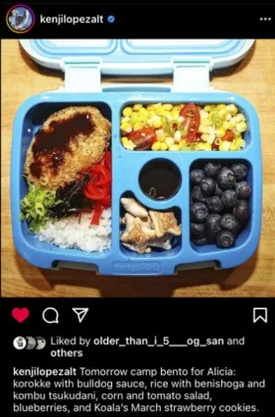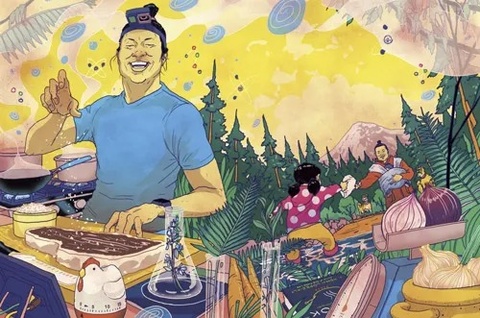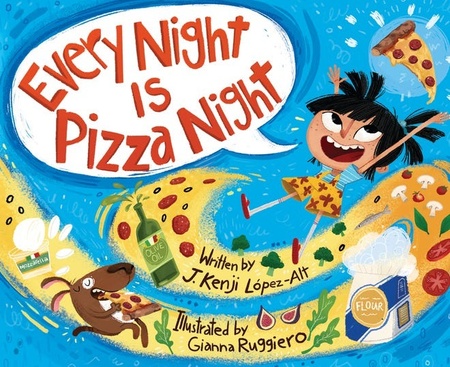Over the years, you really delved into the science behind cooking as in your two cookbooks— is that due to you and your family’s scientific background? Has that been a perfect confluence of your two passions – science and cooking?
Whenever we had family dinners, with my dad being a geneticist and my grandfather being a chemist, where both of them were there, the conversation would be all about science. I became familiar with the language of science and it was always my favorite subject in school.
As I was working in restaurants, I had this growing list of questions like why are we doing it this way? Why do we make the pasta this way? Why do we boil the potatoes like that? Why do we sear this meat like that?
All these questions that I wanted to answer for myself, but I never had the time to do it. Eventually, I transitioned over to writing about food but it started with Cook’s Illustrated magazine in Boston. It was an incredibly rigorous month-long application process. I got the job. Happily, when I said I want to answer this cooking question, they’d say, “Yeah, go ahead and do it!”
A subject like science can be dry but I find that the excitement comes when you can show people how science can apply to their macaroni and cheese. Then suddenly, science is exciting to them.
How did you develop your writing to the point of publishing some really outstanding books?
I had never considered myself a writer or a communicator. Basically, I would spend time writing when not cooking or testing because I wanted to get better at writing.
I never really have a future vision. But I’ve always found that since I was a kid, it was very difficult for me to put a lot of work into something that I didn’t enjoy. If I find the thing I enjoy and concentrate my effort there, I’m going to get better.
I think there’s no better way to develop a writing voice than by just writing all the time. So that was the genesis for The Food Lab book which was a five-year long process.
What was the inspiration for your children’s book Every Night is Pizza Night?
I was inspired to write it by my daughter Alicia, who was around two years old when I started writing it and four years old when it was published. The characters in the book are directly inspired by my family and the experiences I had growing up in New York, as well as those of my illustrating partner Gianna Ruggiero’s experiences growing up in Philadelphia.
Every Night is Pizza Night is a popular children’s book that explores the idea of what counts as the “best” food. The main character thinks that pizza is the greatest food ever, but she meets other children from different cultural backgrounds who tell her that their favorite foods are actually the best.
This children’s book was to help kids understand the idea that “best” is contextual–also, that “best” is personal. So it’s like, what might be best for me might not be best for you. Also, what might be best for me right now, might not be best for me tomorrow. And that’s okay, right? And to use it as a purely positive thing without having to use it to put other people down or using as a way to close your mind.
Can you expand more about your philosophy about your cooking?
There’s no particular food that I feel is very closely tied with my identity. Many of my generation (maybe in their 40s) grew up with two working parents. Perhaps they didn’t have this culture of cooking at home or having the one parent who cooked their family recipes at home.
They might have had takeout food a lot, or they might have had someone who followed, like my mom did, recipes from various books. And so, when you didn’t learn a specific way to cook and you didn’t have these family recipes, or have these techniques that you knew to fall back on, you could modify any recipe to suit your own tastes, when armed with good technical knowledge and information.
What do you consider your greatest cooking passion or idea?
I think my most popular recipe has probably been the ‘no knead, no stretch pizza’ where you basically just make a really loose dough, let it spread itself out into a cast iron pan, and bake it. That’s the recipe I think that I see posted most often.
What I’m more proud of, rather than specific techniques or recipes, is just getting people more engaged in thinking about food in many different ways. I don’t think there’s one way that’s better or worse than another.
What about your life today in Seattle as a busy husband and parent?
My wife, Adriana López-Alt, is in the computer industry. We moved to Seattle two years ago from the Bay Area. We have a five-and-a-half-yearold daughter and a 10-month-old son. Like all young families, balancing work and life has been a challenge!
Over the last few years, I’ve become very good at saying NO to things. When I was younger, like in my 20s and 30s, if someone came to me with an idea that sounded fun, I would say, “Yeah, of course I’ll do that.” Now I think I have a healthy and structured balance where I get to spend a lot of time with my kids.
Do you most enjoy cooking at home?
A couple years ago, I started doing YouTube content. The formula I found that’s worked for me is that I don’t script anything. The basic rule is that I don’t plan what I’m going to make.

If I’m going to be cooking something for my family anyway and if I am in the house by myself and my camera is nearby, then I will shoot the process and show how I’m doing it.
It works great to be able to do these videos where I just cook by myself. I’m able to explain why I’m doing things and how I’m deviating from a recipe. I think one of the running jokes in my videos is that I never follow the recipes that I wrote!
The videos are actually a very good companion to the book because the book has this feeling that readers think is really dense; like here’s this recipe with 40 ingredients and I have to follow it exactly. Whereas ideally, what I want you to take from the book is the techniques and the science, then apply them to your everyday cooking.
I think the fact that it’s a real person cooking real food for their real family is what is most appealing about the videos. There’s a lot of slickly-produced food videos and content out there that makes it feel like you can’t do it!
What would you say about Seattle’s food scene as compared to other cities?
I love the food scene in Seattle.
I grew up in New York, but for me, New York has always been too big. There’s always so much happening that you just feel like you are always in this perpetual race and feel like you’re missing out. Seattle has a comfortable food scene.
Take seafood, for example. Seattle reminds me of Boston; both towns I think have the best sort of casual seafood scene. You can go to fish and chip places which are around everywhere and very fresh and affordable.
A theme I found in Seattle restaurants is that they’re casual and relaxed, right? If I go to Canlis, I may have to wear a jacket but maybe anywhere else I can be dressed however I want!
Regarding your latest book, The Wok, with endless tips and techniques and gorgeous photos, what would you say to our readers who are already familiar with cooking with a wok?

Well, my first piece of advice would be that if you’ve been cooking with a wok your whole life, you should continue to cook the way you cook. If you’ve enjoyed cooking with it and you enjoy the dishes you like to make, there’s no reason to change those things.
That said, if you’re more well-versed, for example, in Japanese dishes, (like my mom cooked a lot of Japanese dishes in the wok growing up and my dad cooked Chinese dishes), then keep cooking those. Today, the wok has been adopted by many other Asian cultures so if you’re familiar with one specific cuisine and you want to expand your repertoire into other cuisines, that would be a good reason to buy the book.
While there are a lot of recipes, I really try and drill down into the technique and science behind it and why you might want to cook things a certain way. For example, why you might want to wash meat, which is a contentious topic, but there are measurable texture benefits to washing your meat vigorously, or why you might want to treat your meat with baking soda or techniques like ‘velveting’ that some people might not be familiar with.
What’s next for you?
Right now, I’m working on a new book, and of course, this might change. The idea is western-style Japanese American cuisine, or Japanese-influenced American dishes. And travel, more videos, and visiting more local restaurants and posting about them!
Video interview with author Elaine and Kenji, 2022.
* This article was originally published in The North American Post on September 23, 2022.
© 2022 Elaine Ikoma Ko








